You’ll need jewelry-grade wire in 21-22 gauge square and half-round varieties, preferably dead-soft copper or bronze for beginners. Essential tools include round nose, flat nose, and chain nose pliers, plus quality flush cutters and measuring rulers. Select a focal cabochon or stone that matches your wire gauge—larger stones require heavier wire for proper support. Don’t forget safety glasses, finishing files, and a well-organized workspace. The complete guide below covers every detail you’ll need for professional results.
Essential Wire Types and Gauges for Pendant Making
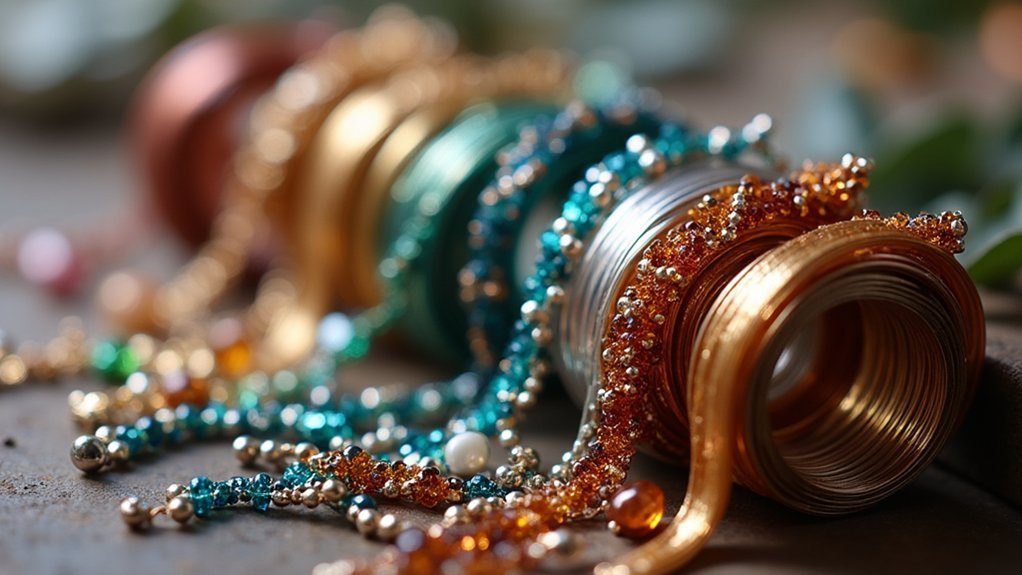
Success in wire wrapped pendant making starts with selecting the right materials for your project.
You’ll need jewelry grade wire, with copper and bronze being ideal beginner choices due to their affordability and ease of use. For best results, use 21 or 22 gauge square wire for your main structure and 22 gauge half round wire for wrapping and detailing work.
Choose dead-soft wire as it’s easier to manipulate and shape during the wrapping process.
You’ll typically need 5-10 feet of square wire depending on your cabochon’s size, plus 5 feet of half round wire. Along with quality wire, invest in proper wrapping tools to guarantee clean, professional results.
Once you’ve mastered these basics, you can advance to premium sterling silver or gold wire.
Selecting the Right Focal Stone or Cabochon
When selecting your focal stone, you’ll need to contemplate how its shape affects your wrapping approach—round cabochons require different techniques than teardrop or freeform stones.
The size of your cabochon directly impacts both wire gauge selection and design complexity, with larger stones demanding heavier wire and more elaborate securing methods.
You’ll find that oval and rectangular shapes offer the most versatility for beginners, while irregular shapes challenge you to create custom wrapping patterns that complement their unique contours.
Stone Shape Considerations
The foundation of any stunning wire wrapped pendant lies in choosing the perfect focal stone or cabochon. Stone shape dramatically impacts your wrapping approach and final design outcome. Oval and round cabochons offer predictable symmetry, making them ideal for beginners learning to wrap wire around curved edges consistently. Freeform stones present exciting challenges but require advanced techniques to secure properly.
Consider these key factors when evaluating stone shape:
- Curved edges work better than sharp angles for smooth wire flow
- Flat or slightly curved backs provide stable mounting surfaces
- Proportional dimensions guarantee balanced pendant weight distribution
- Natural contours guide your wire placement for organic-looking designs
Your chosen shape determines wire gauge requirements and wrapping complexity, so select stones that match your skill level while inspiring creative expression.
Cabochon Size Guidelines
Cabochon size directly influences your pendant’s visual impact, structural integrity, and wearability. You’ll typically work with stones ranging from 10mm to 30mm in diameter, though your specific design determines the ideal dimensions.
| Size Range | Wire Gauge | Design Complexity |
|---|---|---|
| 10-15mm | 20-18 AWG | Simple wraps |
| 16-25mm | 18-16 AWG | Moderate detail |
| 26-30mm+ | 16-14 AWG | Complex frameworks |
Larger cabochons require more wire to make secure settings and provide adequate support. You’ll need thicker gauges for stones exceeding 25mm to prevent structural failure. Consider the stone’s thickness alongside diameter—thicker cabochons demand more robust wire frameworks. Balance your cabochon size with the intended wearer’s comfort, as oversized pendants can feel heavy and cumbersome during extended wear.
Must-Have Pliers for Wire Manipulation
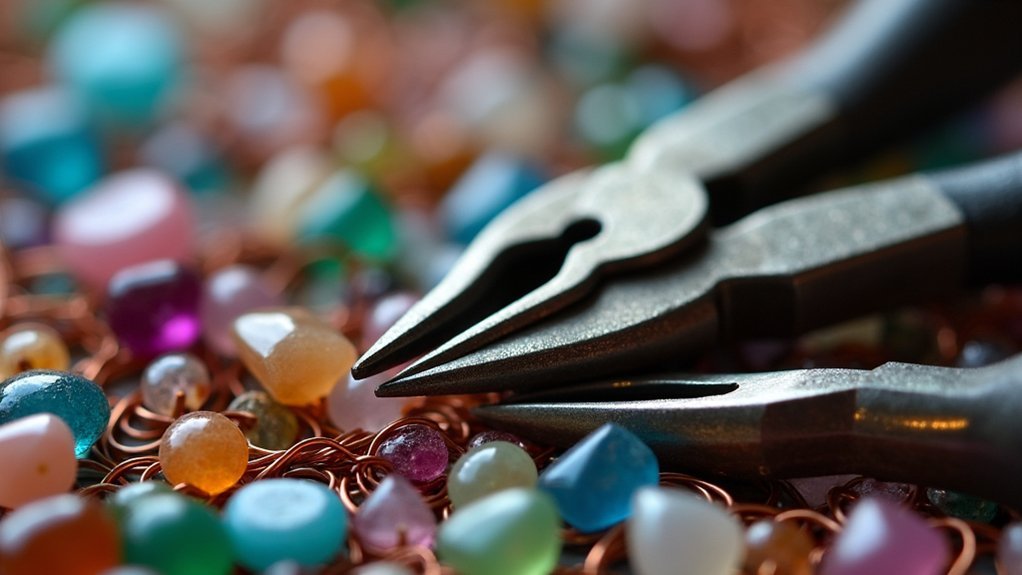
You’ll need three essential pliers to master wire manipulation in pendant making.
Round nose pliers create perfect loops and curves, while flat nose pliers give you the grip strength needed for sharp bends and angles.
Chain nose pliers complete your toolkit by providing precision control for detailed wrapping work and securing components without marking your wire.
Round Nose Loop Creation
When crafting wire wrapped pendants, round nose pliers become your most essential tool for creating the smooth loops that’ll hold your entire design together.
These specialized pliers feature tapered tips that let you form uniform loops of various sizes, which are vital for securing beads and pendant components. You’ll grip the wire firmly at your desired point and roll the pliers to create consistent loops throughout your design.
Round nose pliers make loop creation straightforward when you follow these techniques:
- Choose different plier sizes to create varying loop diameters for your specific project needs
- Grip the wire at the exact spot where you want your loop to begin
- Roll the pliers smoothly to avoid kinks or irregular shapes
- Practice consistent pressure to achieve uniform loops across your entire pendant design
Flat Nose Wire Bending
Flat nose pliers serve as your precision control center for wire manipulation, offering the grip strength and accuracy needed to create sharp angles and clean bends in your pendant designs.
These essential tools feature flat, wide surfaces that let you make precise angles without damaging delicate wire. You’ll find them invaluable when wrapping beads, as they provide superior control for positioning and securing wire around stones or focal elements.
Their flat jaws excel at flattening and crimping wire ends, creating professional-looking finishes that enhance your pendant’s overall appearance.
When manipulating sheet metal or creating intricate wire patterns, flat nose pliers give you the leverage needed for complex shapes.
Investing in high-quality flat nose pliers improves your comfort and efficiency throughout the wire wrapping process.
Chain Nose Precision Gripping
Chain nose pliers function as your primary gripping tool, delivering the precision control essential for manipulating fine wire details in pendant creation.
Their flat inner surface and tapered nose design grants superior access to tight spaces while maintaining complete control over delicate wire movements. You’ll find these indispensable for creating tight bends and smooth curves when securing wire wraps around cabochons or gemstones.
- Precision gripping – Flat surfaces provide secure holds without damaging wire texture or finish
- Versatile functionality – Perfect for opening jump rings and connecting multiple pendant components
- Enhanced accessibility – Tapered nose reaches confined areas other tools can’t access effectively
- Professional results – High-quality chain nose pliers improve comfort and efficiency during wire wrapping sessions
Wire Cutters and Cutting Tools
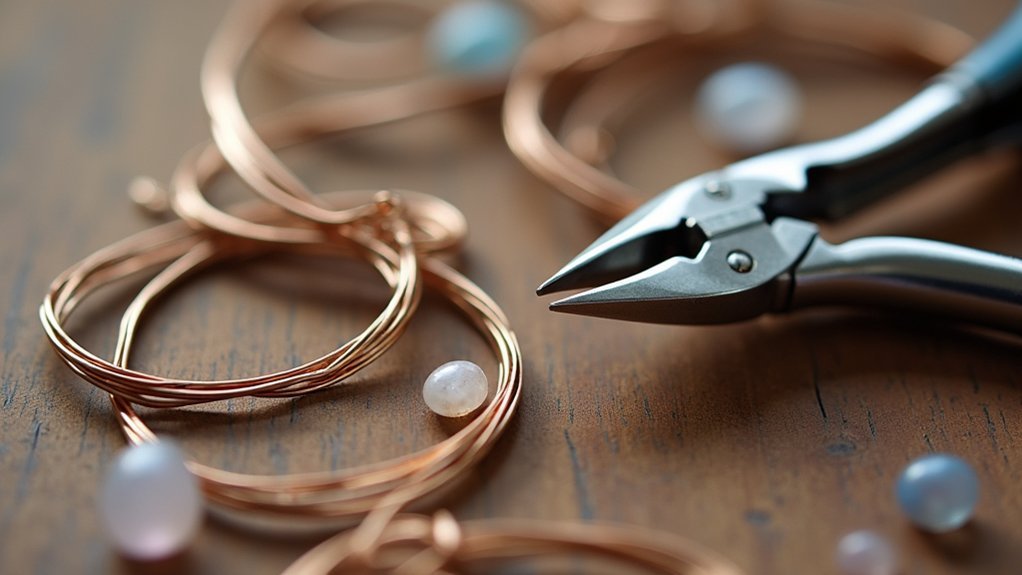
Precision forms the foundation of professional-looking wire wrapped pendants, and high-quality wire cutters are your first line of defense against amateur-looking finishes. These essential cutting tools deliver flush cuts that create clean, precise edges on your wire wraps.
You’ll find flush cutters comfortable for wire thicknesses up to 16 gauge, making them versatile for most projects. However, different wire cutters are designed for specific thicknesses, so choose accordingly based on your materials.
A ruler guarantees accurate wire length measurements, maintaining consistency across your designs.
Don’t overlook finishing tools like needle files and sandpaper – they’re vital for smoothing sharp edges on cut wire. This extra step prevents discomfort when wearing your finished jewelry pieces.
Measuring Tools and Rulers
Accurate measurements transform your wire wrapping from guesswork into professional craftsmanship, and proper measuring tools guarantee every pendant meets your exact specifications.
You’ll need a ruler to measure wire lengths and determine your cabochon’s dimensions precisely. Roll your cabochon along the ruler to find its circumference, then add 12-14 inches to accommodate the bail and rosettes.
Essential measuring practices include:
- Use a marker to mark the wire at measured points for accurate cutting
- Measure consistently across multiple pendants to maintain uniformity
- Double-check measurements before cutting to prevent waste
- Keep your measuring tools clean for clear readings
These measuring tools assure you’ll cut appropriate wire lengths every time, eliminating costly mistakes and creating professional-quality pendants that match your design vision perfectly.
Mandrels and Shaping Equipment
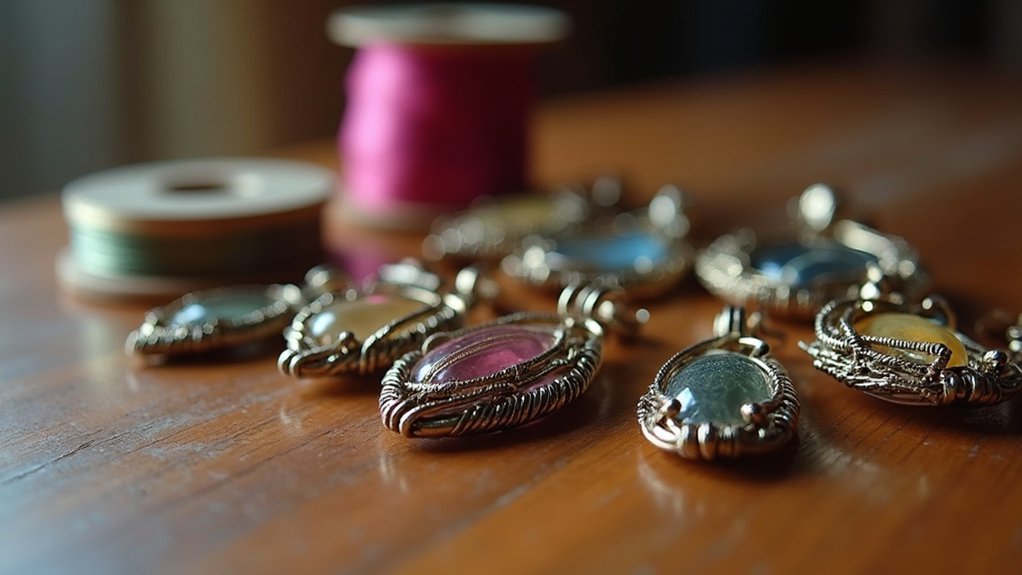
You’ll need reliable mandrels and shaping equipment to create professional-looking wire wrapped pendants with consistent curves and dimensions.
Ring mandrels give you precise sizing control, while bracelet mandrels excel at forming larger circular components for your designs.
Don’t overlook alternative shaping tools like rubber mallets and steel bench blocks, which work alongside mandrels to protect your wire’s finish and provide stable work surfaces.
Choosing Ring Mandrels
Several key factors determine which ring mandrel will best serve your wire wrapping projects.
You’ll need to take into account the material, size markings, and design features that match your specific needs for creating wire wrapped jewelry.
When selecting ring mandrels for your toolkit, evaluate these essential characteristics:
- Material durability – Metal mandrels offer longevity and precision, while wooden options provide gentler shaping for delicate wires.
- Size markings – Clear, accurate measurements along the length guarantee consistent ring dimensions throughout your projects.
- Tapered design – Graduated width allows you to create rings of varying sizes and adjust fit during the shaping process.
- Surface finish – Smooth surfaces prevent wire damage and scratching during the wrapping and forming stages.
Choose mandrels that complement your wire gauge preferences and project complexity levels.
Bracelet Mandrel Benefits
While ring mandrels excel at creating circular jewelry pieces, bracelet mandrels offer specialized advantages that transform your wire wrapping workflow for wrist-worn designs.
These essential tools for wire wrapping provide consistent sizing and shaping capabilities that guarantee professional results every time.
A bracelet mandrel’s tapered design accommodates various wrist sizes, letting you create custom pieces tailored to individual preferences.
You’ll achieve perfectly shaped bracelets without damaging delicate wire materials, as the solid surface supports your bending and forming techniques.
This tool also corrects existing wire designs, transforming imperfect shapes into polished, professional pieces.
Your crafting efficiency improves dramatically when using a bracelet mandrel, reducing time spent on adjustments and reworking.
You’ll spend less time troubleshooting and more time creating beautiful wire wrapped jewelry.
Alternative Shaping Tools
Beyond traditional mandrels, countless specialized shaping tools can elevate your wire wrapping technique and expand your creative possibilities.
These alternative tools offer unique advantages for creating professional-quality pendants with distinct characteristics and finishes.
A convex chasing hammer transforms ordinary wire into textured masterpieces, flattening and adding visual interest to your designs.
Rubber mallets provide gentle shaping power without damaging delicate wire surfaces, making them perfect for intricate work.
Steel bench blocks create the solid foundation you need for effective cold-forging techniques, helping refine and perfect your wire wrapped shapes.
- Convex chasing hammers – Flatten and texture wire for unique design elements
- Rubber mallets – Shape wire gently without surface damage
- Steel bench blocks – Provide solid surfaces for cold-forging techniques
- Specialized forming tools – Expand creative possibilities beyond basic mandrels
Hammers for Work-Hardening Wire
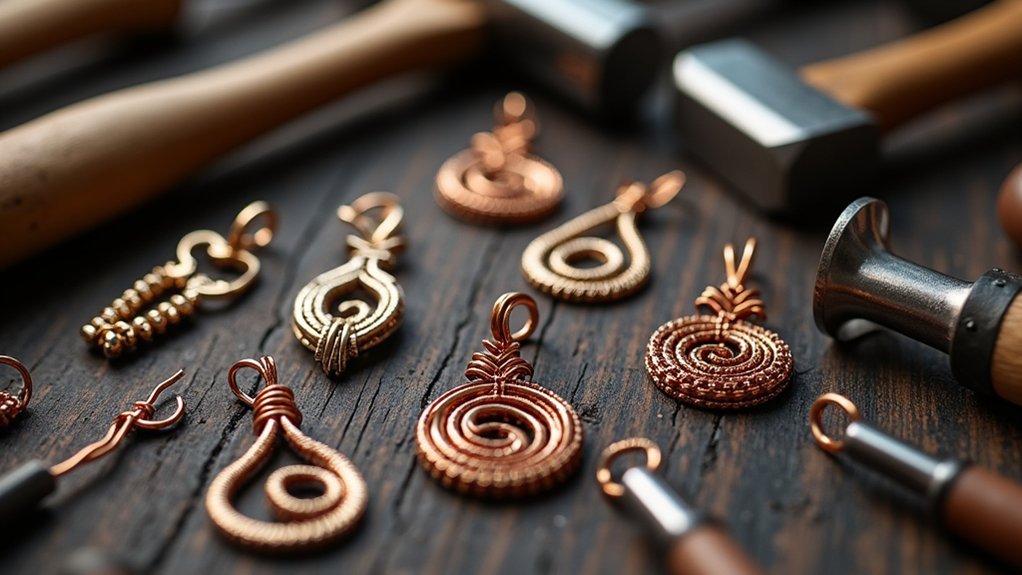
When crafting wire-wrapped pendants, you’ll need the right hammers to properly work-harden your wire and achieve professional results. Jewellers’ hammers are specifically designed for work-hardening wire, making it more durable and resistant to deformation during crafting.
You’ll find rawhide hammers particularly useful for strengthening base frame wire without marring the surface, preserving your pendant’s aesthetic appeal.
Consider adding a repousse hammer to your toolkit for creating texture and flattening wire, enabling creative design variations in your pendants.
Using multiple hammer types benefits your work by achieving different effects like shaping, hardening, and texturing wire across various designs.
Remember that proper hammering techniques are essential for maintaining wire integrity and overall design quality throughout your crafting process.
Files and Finishing Supplies
Polishing off your wire-wrapped pendant requires dedicated attention to files and finishing supplies that transform rough cuts into comfortable, wearable jewelry.
You’ll need various files and sandpaper grits ranging from 600 to 2000 to smooth sharp edges and achieve professional results. Coarser grits remove material quickly, while finer grits create that polished surface you’re after.
Essential files and finishing supplies for your toolkit:
- Metal files in different cuts for initial edge smoothing
- Sandpaper sheets from 600-2000 grit for progressive finishing
- Polishing cloth or fabric for final buffing stages
- Steel wool for texture refinement and shine enhancement
Regular filing and sanding prevent uncomfortable rough spots that could cause injury.
These finishing supplies aren’t optional—they’re what separate amateur work from professional-looking wire-wrapped pendants.
Patina and Polishing Materials
After achieving smooth surfaces through filing and sanding, you can transform your wire-wrapped pendant’s appearance with specialized patina and polishing materials.
Patina solutions like liver of sulfur or vinegar create an aged, antique look by oxidizing the metal surface. You’ll want to test these solutions on scrap wire first to achieve your desired effect.
Polishing materials such as polishing cloths or rouge compounds enhance the wire’s shine while removing tarnish and oxidation. A micro-fiber cloth works perfectly for buffing your pendant after applying patina or polish, ensuring a smooth finish without scratching.
Consider using jewelry-grade sealants to protect your patina finish and prevent further oxidation, preserving your pendant’s appearance long-term.
Cord and Chain Options for Hanging
The right cord or chain can dramatically transform your wire-wrapped pendant from a beautiful centerpiece into a complete, wearable work of art.
A thoughtfully chosen cord elevates your wire-wrapped creation from simple jewelry to a unified masterpiece that tells your unique artistic story.
When choosing materials, you’ll need to evaluate both aesthetics and functionality. Leather cords offer rustic charm, while cotton provides comfort for everyday wear. Silk adds elegance for formal occasions.
Chain options range from delicate sterling silver to robust stainless steel designs. Assess your pendant’s weight when selecting support materials—heavier pieces require sturdier cord or chain construction.
- Adjustable cotton cords – Perfect for casual wear and customizable lengths
- Sterling silver chains – Ideal for delicate, refined presentations
- Beaded decorative chains – Add artistic flair to enhance visual appeal
- Leather cords – Provide natural, earthy aesthetics for bohemian styles
Additional Decorative Elements and Beads
Beyond selecting the perfect cord or chain, you can transform your wire-wrapped pendant with carefully chosen decorative elements that add personality and visual depth.
Beads serve as versatile additions that enhance both color and texture in your design. High-quality options like semi-precious stones or glass beads create striking visual contrasts against metallic wire.
You’ll incorporate these decorative elements by creating secure loops within your wire wrapping technique. This method allows beads to become integral parts of dynamic shapes and patterns rather than simple add-ons.
Consider mixing various bead sizes and shapes to achieve dimensional interest while maintaining structural balance.
Crystals and pearls elevate your pendant’s sophistication, making pieces suitable for formal occasions or distinctive personal style statements that reflect your creative vision.
Safety Equipment and Workspace Setup
Why risk injury when proper safety equipment and workspace setup can transform your wire wrapping experience from hazardous to enjoyable?
You’ll need essential safety equipment to protect yourself while creating beautiful pendants. Safety glasses prevent flying wire pieces from damaging your eyes during cutting and manipulation. A first aid kit handles minor cuts from sharp wire ends.
Your workspace setup directly impacts both safety and efficiency. Organize all tools and materials within easy reach to avoid dangerous distractions. Use a non-slip mat to keep everything stable during intricate work. Guarantee adequate lighting for precision with small components.
- Wear safety glasses when cutting or manipulating wire
- Keep your workspace clean and organized for efficiency
- Use a non-slip mat to prevent materials from moving
- Maintain proper lighting for detailed work visibility
Quality Considerations for Professional Results
While proper safety measures protect you during creation, selecting quality materials and tools determines whether your finished pendant looks handmade or professionally crafted.
You’ll want to invest in high-quality pliers with different sizes, including flat nose, round nose, and flush cutters, to achieve clean cuts and precise bends. For wire selection, begin with jewelry grade copper or bronze if you’re starting out, then advance to sterling silver wire for premium finishes.
Choose 21 or 22 gauge square wire with 22 gauge half round wire for maximum durability. Consider investing in mandrels or triblets for consistent shapes, and maintain files and sandpaper for smooth finishing touches that guarantee comfortable wearability.
Frequently Asked Questions
What Do I Need to Start Making Wire Wrapped Jewelry?
You’ll need 21-22 gauge square wire, 22 gauge half round wire, flat nose pliers, round nose pliers, wire cutters, a mandrel, ruler, and marker. Start with copper wire before upgrading to silver.
What Is the Best Material for Wire Wrapping Jewelry?
You’ll find sterling silver wire works best for wire wrapping jewelry due to its durability and professional appearance. Copper’s also excellent for beginners since it’s affordable and malleable, letting you practice techniques easily.
What Do You Coat Wire Jewelry With?
You can coat wire jewelry with Renaissance Wax for professional protection, clear nail polish for quick accessibility, or specialized patinas for artistic effects. Always let coatings dry completely before wearing.
What Gauge Wire Do I Need for Wire Wrapping Jewelry?
You’ll need 20-22 gauge square wire for structural work and settings, plus 22 gauge half-round wire for wrapping. Start with 21-22 gauge as a beginner—it’s strong yet flexible for learning techniques.
In Summary
You’ve got everything you need to start creating beautiful wire wrapped pendants. Remember, you don’t need to buy premium materials right away—start with basic copper wire and simple stones to practice your techniques. As you develop your skills, you’ll naturally upgrade to better quality wires and more stunning focal pieces. Focus on mastering the fundamentals first, then let your creativity guide your material choices for truly unique designs.

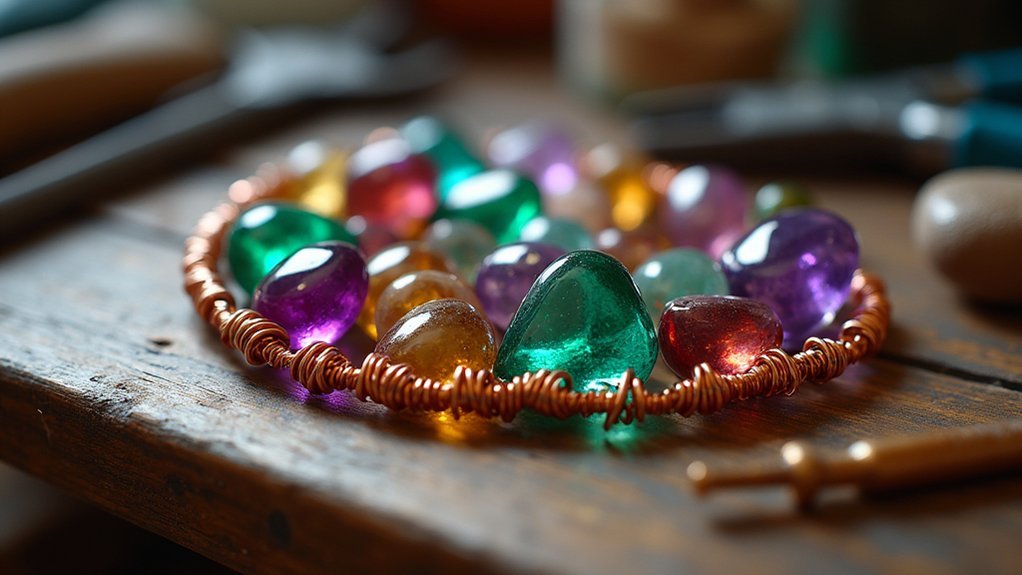



Leave a Reply